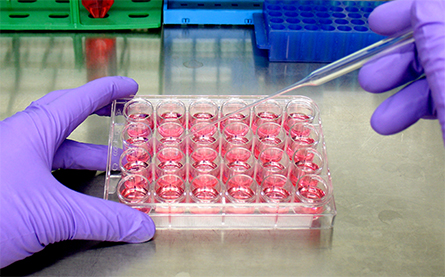Rethinking how culture medium contributes to cellular function
Cell culture medium, as we know, contains a combination of growth factors and other components that help researchers grow cells in the lab. An important constituent in the growth medium is serum, an animal-derived complex of growth factors, amino acids and lipids, which provides nutrition to the growing cells. Researchers lack complete information on serum composition and its lot-to-lot variability but have studied the effects of some growth medium components on cellular metabolism. However, they do not yet understand fully the impact of the medium’s lipid content on cell function.

The powerhouse of human cells is mitochondria. An important component that determines mitochondrial function is cardiolipins, or CLs. These phospholipids located on the inner mitochondrial membrane are involved in mitochondrial bioenergetics and maintaining architecture of the mitochondrial membranes as well as in scavenging reactive oxygen species. However, cardiolipin composition is different in different tissues of the body, and because CLs play a central role in mitochondrial function, this means cells in different organs have varied mitochondrial activity.
To better understand the effect of nutrition, especially lipids, on mitochondrial CL composition and function, Markus Keller’s lab at the Medical University of Innsbruck in Austria cultured mammalian cells in lipid-free medium and then fed them with various types of lipids. Using mass spectrometry lipidomics and mathematical modeling, the authors were able to quantify the CL composition in the presence of different fatty acids in the growth medium.
Specifically, addition of linoleic acid to the medium altered 76% of the natural CL side chain composition compared to untreated medium. Addition of alpha linolenic acid and arachidonic acid also altered CL side chain composition significantly. Moreover, linoleic acid treatment increased the activity of the mitochondrial respiratory complex I, which is responsible for generating ATP and thus regulates normal functioning of a cell. The lab’s breakthrough findings were published in the Journal of Lipid Research.
Gregor Oemer, the first author on the paper, said an initial challenge of this project was finding cells that would grow without lipids, which are usually necessary for cell proliferation. “We got Panserin 401 (a serum-free medium) from a German biotech company and luckily got our HeLa cells to grow in this lipid-free medium,” he said.
The work was a collaborative effort. “We were in luck because Innsbruck is the home base for Oroboros, one of the most renowned respirometry companies,” Oemer said, “and thanks to Erich Gnaiger, the head, we collaborated for the respirometry assays.”
This project was a continuation of Oemer’s master’s thesis from the Keller lab. “Lipid metabolism is very complex but quite fascinating, and we don’t know much about it,” he said.
What struck Oemer most was how, by just altering the lipid intake, the researchers were able to influence critical cellular functions. He hopes the work raises awareness that variations in serum in cell culture medium may alter experimental data. This is especially important while studying diseases such as Barth syndrome, a genetic disorder characterized by abnormalities in mitochondrial cardiolipins.
Enjoy reading ASBMB Today?
Become a member to receive the print edition monthly and the digital edition weekly.
Learn moreGet the latest from ASBMB Today
Enter your email address, and we’ll send you a weekly email with recent articles, interviews and more.
Latest in Science
Science highlights or most popular articles

What is metabolism
A biochemist explains how different people convert energy differently – and why that matters for your health.

What’s next in the Ozempic era
Diabetes, weight loss and now heart health: A new family of drugs is changing the way scientists are thinking about obesity — and more uses are on the horizon.

How a gene spurs tooth development
University of Iowa researchers find a clue in a rare genetic disorder’s missing chromosome.

New class of antimicrobials discovered in soil bacteria
Scientists have mined Streptomyces for antibiotics for nearly a century, but the newly identified umbrella toxin escaped notice.

New study finds potential targets at chromosome ends for degenerative disease prevention
UC Santa Cruz inventors of nanopore sequencing hail innovative use of their revolutionary genetic-reading technique.

From the journals: JLR
How lipogenesis works in liver steatosis. Removing protein aggregates from stressed cells. Linking plasma lipid profiles to cardiovascular health. Read about recent papers on these topics.

